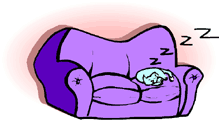Prepositions

A preposition links a noun, pronoun, or phrase to another part of a sentence. Because many prepositions show direction, some say that "a preposition is anywhere a cat can go."
 |
The cat walked across the couch.
The cat leaned against the couch.
The cat strolled along the couch.
The cat sneaked around the couch.
The cat leapt at the couch.
The cat crept behind the couch.
The cat hid below the couch.
The cat scampered beneath the couch.
The cat leaned beside the couch.
The cat tip-toed by the couch.
The cat crawled inside the couch.
The cat strutted near the couch.
The cat jumped off the couch.
The cat marched over the couch.
The cat rambled past the couch.
The cat plodded to the couch.
The cat stalked toward the couch.
The cat wiggled underneath the couch.
The cat settled upon the couch.
The cat snuggled within the couch.
A preposition leads to an object, which is the part of the sentence that receives the action of the verb. The preposition also tells how the object is related to the rest of the sentence.
The cat walked across the couch.
The couch is the object, because it receives the action of the verb—the walking. The preposition, across, tells how the couch is related to the rest of the sentence. It links the fact that the cat walked with information about where it walked: across the couch.
Prepositions can help show not just where something took place, but how and when. Besides the ones listed above, some common prepositions are about, after, among, between, beyond, but, despite, during, for, of, since, through, until, and without.
See also: Prepositions: Good Things Come in Small Packages and Prepositional Phrases: The Big Daddy of Phrases.
